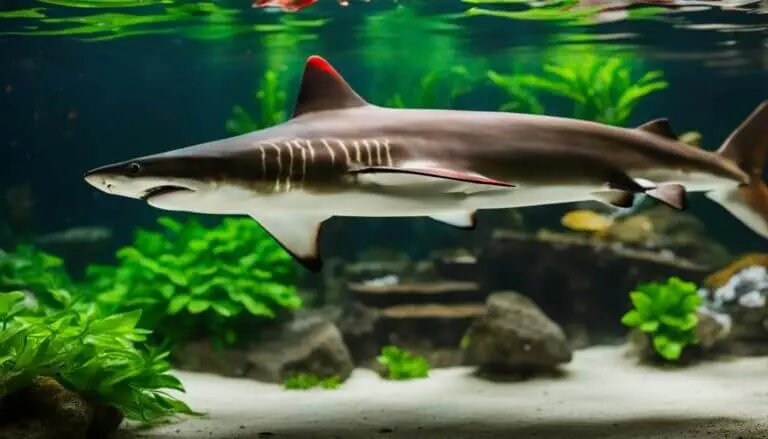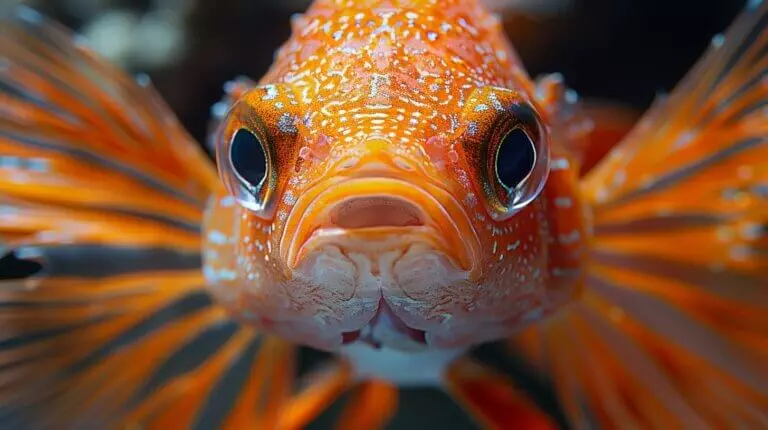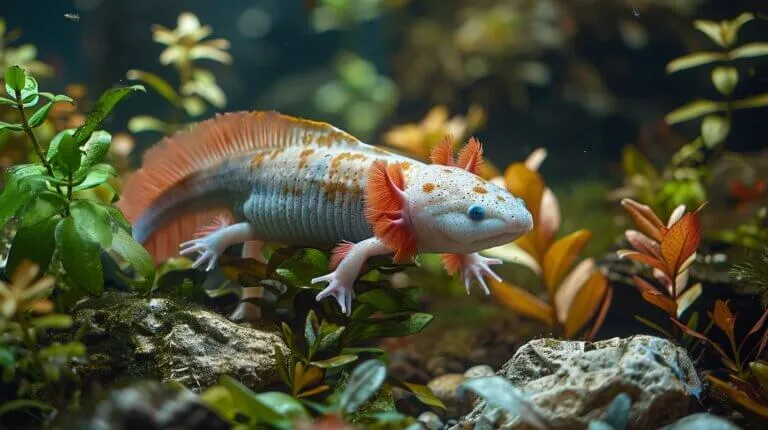When considering adding large fish to a spacious aquarium, aquarists must think beyond just filling the space. It is important to choose species that will thrive in a larger environment while adding visual interest.
Options like Oscars, Common Plecostomus, and Bala Sharks require ample room and bring unique behaviors and needs that make tanks more dynamic.
Let’s explore which fish make the top picks and what we need to know to keep them happy and healthy in our aquariums.
Key Takeaways
- Oscars are large, predatory fish that require ample space and a well-maintained environment.
- Common Plecostomus can grow up to 24 inches and are excellent algae eaters.
- Redtail Catfish are striking and bold, needing spacious tanks to thrive.
- Bala Sharks prefer large tanks and contribute to dynamic aquarium environments.
- Angelfish are graceful and require roomy tanks with compatible tank mates.
Understanding the Basics: Large Fish Suitable for Tank Environments

When selecting large fish for tank environments, understanding the differences between freshwater and saltwater species is vital. Freshwater fish tend to be more forgiving and easier to care for, making them popular for those seeking freedom from complex setups.
Big freshwater fish like Oscars and Redtail Catfish require spacious aquariums to thrive. They need a tank of at least 75 gallons, but bigger is always better. Large size tanks provide these magnificent creatures with room to swim freely, reducing stress and promoting natural behaviors.
The goal is to create an environment that mimics a natural habitat as closely as possible. Overcrowding can lead to health issues and aggressive behavior.
Tank Behavior and Environment Insights
Certain large fish show distinct behaviors. The Silver Arowana may jump when it sees reflective surfaces or sudden light changes. This trait calls for weighted lids in tanks 1. Oscars are smart and sometimes rearrange their tank substrate as they interact with their space 25.
Substrate type and tank layout matter. Filter-feeding species like the Suckermouth Catfish need tanks of 75+ gallons with proper substrates 15. Tank dimensions are also vital. Banded Leporinus require room for horizontal swimming, while angelfish thrive in tall tanks of at least 40 cm 914.
Spotlight on Freshwater Aquarium Fish: Species Selection and Care

Choosing the right freshwater aquarium fish involves understanding each species’ unique needs and characteristics. We must consider compatibility with tank mates, planted tanks, and overall care for large freshwater options.
Oscars, for example, have strong personalities and can grow up to a foot long. As predators, they shouldn’t be housed with smaller fish. They need plenty of space and a well-filtered environment to thrive.
Then there’s the Common Plecostomus, or Pleco, which can grow up to 24 inches and loves hiding among decorations and plants.
For semi-aggressive fish lovers, consider Barb and Bala Shark. Barbs can be quite feisty, while Bala Sharks can grow up to 14 inches and prefer swimming in schools. Both like a spacious tank with effective filtration.
Lastly, Goldfish can grow large and require a lot of space to swim freely. A well-maintained planted tank with ample room will keep them happy and healthy.
Catfish: Varieties Suitable for Large Aquariums

Catfish captivate with their unique appearances and behaviors. Aquarists must take into account their specific needs to guarantee they thrive.
- Corydoras Catfish: Peaceful and group-oriented.
- Pictus Catfish: Known for long whiskers and active swimming habits, and requiring specific fish food.
- Plecostomus (Plecos): Excellent algae eaters.
- Synodontis Catfish: Unique upside-down swimmers.
- Redtail Catfish: Bold and striking, suitable for well-maintained spacious aquariums.
It is important to prevent common diseases with regular water changes, proper filtration, and avoiding overcrowding.
Additional care guidelines include testing the water in the freshwater tank weekly. Check pH, ammonia, and nitrate levels. Use an effective filtration system and clean it regularly. Set a regular feeding schedule with quality fish food from a pet store.
Monitor fish behavior for signs of stress or illness.
The Lively Schooling Fish: Enhancing Aquarium Dynamics

Schooling fish like tetras and barbs can greatly enhance the dynamic and visually appealing nature of large aquariums. These social creatures thrive in groups, and their behavior reflects their need for companionship.
To maintain a healthy and happy aquarium community, aquarists must understand the specific needs of these schooling fish. They require ample swimming space, stable water conditions, and a well-balanced diet. Providing hiding spots and plants can also make them feel secure and reduce stress.
Cichlids and Angelfish: The Attractive Freshwater Options

Cichlids and angelfish are top choices for adding vibrant and elegant residents to large aquariums. Both species bring a touch of beauty and activity, making them visually enchanting and engaging to watch.
To maintain harmony in tanks, consider the following:
- Tank Size: Both species thrive in spacious environments.
- Tank Mates: Choose compatible species to avoid conflicts.
- Hiding Spots: Provide plenty of hiding places to reduce stress.
- Feeding Requirements: Both have specific dietary needs.
- Water Conditions: Maintain consistent water parameters for best health.
Equipment and Health Monitoring Tips
Proper equipment is key. In 75-gallon tanks, dual heaters of 100W each help keep the water warm for large cichlids 15. Sponge filters lower current stress for catfish and create a calm home 78. These choices affect fish behavior and comfort.
Regular health tests are a must. African Cichlids may show signs of Malawi Bloat when fed too much protein 13. Angelfish may suffer fin rot if the water is not clean 1214. Ethical sourcing also matters. Wild-caught angelfish are rare due to breeding practices 9.
Conclusion
To summarize, we’ve explored a variety of large fish that can thrive in spacious aquariums, from the predatory Oscars to the algae-eating Plecos.
By carefully selecting species like Bala Sharks, Goldfish, and various Cichlids, aquarists can create a vibrant and dynamic aquatic environment.
The importance of providing a well-mimicked natural habitat and ample space for these fascinating creatures guarantees their peak well-being and happiness.
Happy fishkeeping!
Frequently Asked Questions
What are some top picks for large fish for spacious aquariums?
Some top picks for large fish for spacious aquariums are goldfish, bala shark, barb, common plecostomus, oscar, and leaf fish. Also, these large fish can benefit from the presence of top algae eaters to help keep the tank clean and maintain a healthy environment.
Some top algae eaters to consider adding to the tank are the Siamese algae eater, the amano shrimp, and the Bristlenose plecostomus.
What size tank is suitable for large fish like goldfish and bala sharks?
Large fish like goldfish and bala sharks typically require a tank that is at least 55 gallons or more.
What types of fish can be considered semi-aggressive for a community tank with large fish?
Fish such as barbs and tiger fish can be considered semi-aggressive and may not be suitable for all community tank setups with large fish.
Can large fish like Oscars be kept with small fish in a community tank?
Oscars are aggressive and may not be suitable for community tanks with small or little fish as tank mates.
What are some tank requirements for large freshwater fish like plecostomus and leaf fish?
Large freshwater fish like plecostomus and leaf fish require a 300-gallon tank or larger due to their size and behavior.
Disclaimer: This content is informational and does not substitute professional aquarium advice. No sponsorship or affiliate relationships influence the content. The information is based on standard fish care practices and experienced aquarist insights.
References
- ^ https://www.thesprucepets.com/large-fish-for-freshwater-aquariums-7570272
- ^ https://www.youtube.com/watch?v=mD6emDzFIAw
- ^ https://en.wikipedia.org/wiki/List_of_freshwater_aquarium_fish_species
- ^ https://www.aquariumcoop.com/blogs/aquarium/top-10-colorful-fish
- ^ https://www.ratemyfishtank.com/blog/subcategory/saltwater/aquarium-setup
- ^ https://www.youtube.com/watch?v=L2IBk18LiWA
- ^ https://www.aquariumcoop.com/blogs/aquarium/aquarium-shopping-list
- ^ https://www.thesprucepets.com/aquarium-checklist-1380711
- ^ https://www.aqueon.com/resources/care-guides/angelfish
- ^ https://theexoticpets.com/types-of-angelfish-freshwater/
- ^ https://www.livefishdirect.com/basic-care-requirements-of-african-cichlids/
- ^ https://www.petvetcarecenters.com/site/blog/2022/04/30/freshwater-angelfish-care
- ^ https://www.aquariumsource.com/african-cichlids/
- ^ https://en.aqua-fish.net/articles/angelfish-care-diet-breeding-forums
- ^ https://www.livefishdirect.com/whats-the-ideal-tank-set-up-for-cichlids/






